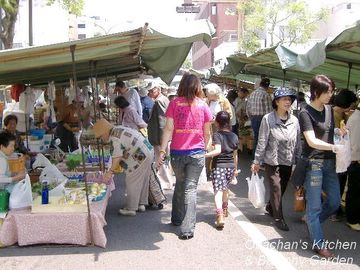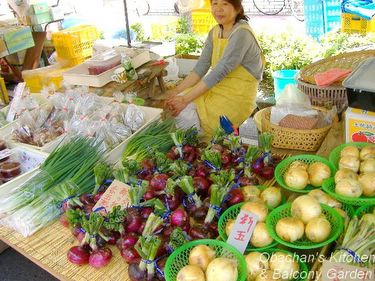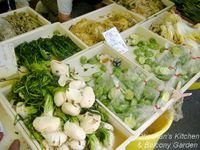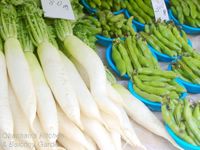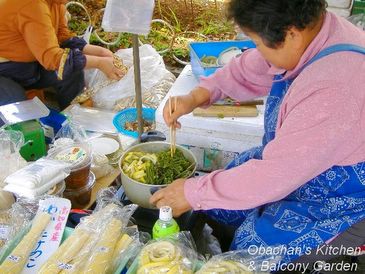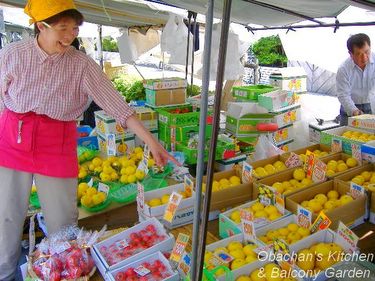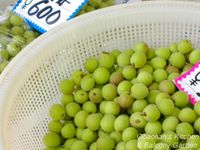 I never meant to post about wagashi on the last day of every month, but looks like that is the way it is going recently, right? See, it tells you that obachan is innately a procrastinator. * OMG!! I just realized that I skipped a wagashi entry for April! I'll do something about it sometime this weekend...  Azalea  Wagashi by OGASAWARA Categories: Wagashi |
Wednesday, May 31, 2006
Sweet Seasons/ May 2006 - Azalea -
Posted by
obachan
at
5/31/2006 11:57:00 PM
7
comments
![]()
Tuesday, May 30, 2006
Meet the Local People at the Sunday Market
Just recently, I found out about the Farmer’s Market International Parade hosted by CookingDiva. It’s been a while since I last posted about our Sunday Market, one of Kochi’s major sightseeing attractions, so I decided to jump in. CLICK PHOTOS TO ENLARGE. As I wrote in my previous post, the Sunday Market in Kochi city has a history of 300 years, and the number of outside stalls along the street (apx. 1.3 km) is said to be over 600 now. This market begins just across the street (well, almost) from the main gate of Kochi castle, so it must have been very convenient for castle employees in the feudal era. It’s so close that I can’t help imagining the feudal lord or his family members sneaking out from the castle once in a while to browse the stalls despite the rigid class system of that time. :) The Sunday Market is not a regular farmer’s market; in addition to things like plants, fish, fruits and vegetables, they sell antiques, clothes, toys, everyday items and even hermit crabs! This is the place where you see fresh foods and kind smiles on local ojichan and obachan’s faces. Read More Coming from the direction of the castle, first you’ll see the stalls of antiques and cutting tools on one side, and those of plants on the other.  All of these patterns are made with 5-yen coins. All of these patterns are made with 5-yen coins.  Mushroom bed logs and cutting tools. Ojichan giving advice to female customers. 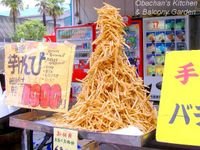 This is Kochi’s local specialty: imo kempi (deep-fried sweet potato strips with icing). You can see this imo-kempi tower right outside Hirome ichiba. This is Kochi’s local specialty: imo kempi (deep-fried sweet potato strips with icing). You can see this imo-kempi tower right outside Hirome ichiba.As I wrote in my previous post, Aisukurin is very popular here in Kochi. And this is the stall of ever-famous Sunday Market imoten (batter-fried sweet potatoes). Don’t miss the best imoten in Kochi! Yuzu citrus products. Bottled yuzu vinegar, yuzu miso, yuzu marmalade, seasonings with freeze-dried yuzu rind added, and more…  So many kinds of green tea and herb tea! So many kinds of green tea and herb tea!Pickles. One of the signs in the right photo says that all of these red pickles were colored with aka-jiso (purple perilla) only, which means, no artificial coloring. Anpanman lollipops and hermit crabs. I was told that these crabs would make lovely pets… :O "Lunch break" Fresh veggies. The vine-like things piled up in the right photo are sweet potato vines. I don’t know about other places, but here in Kochi some people boil them and eat them. They taste quite good when seasoned with dashi, soy sauce, sugar, sake and mirin. Dried fish. Different kinds of baby fish and katsuobushi, another specialty of Kochi. I’m not sure if she was going to sell what she was cooking, or if it was their lunch… This obachan asked me to include her in the photo. She was so excited when I told her that the photo was going to be on the internet. Plum season is just beginning. These green plums are typically used for umeboshi and ume-shu. The tomatoes are what they call “fruit tomatoes” which were bred to improve sweetness. These boxed fruit tomatoes have become a popular souvenir/gift recently, and they can be delivered. Well, these were just a part of the 600 outside stalls in the market. To fully enjoy the adventurous discoveries, come to our Sunday Market and meet local people! :D Many of them have been selling things here every Sunday since their parents’ generation. The venders are friends to each other, and you can see them chatting with each other and helping each other. When you see an unattended stall, venders at the neighboring stalls will tell you where the stall owner went and when (s)he will be back. Or they might even tell you the price of the goods and where to leave the money instead of the absent stall owner. In fact, this is a good place for visitors (esp. those from Western countries) to see something which is different from their common sense. I was once told by one of the venders that they have an unspoken rule here which is: keeping a laid-back, almost outdated harmonious atmosphere is very important in this market. Thus, they do not make outrageous efforts to advertise their products to win more customers than neighboring venders. Winning “against” others is not the biggest priority here. For them, this is a place where people who got tired of individualistic competitions can indulge in a nostalgic atmosphere of good old ways in a small countryside. But this explanation just brought some Westerners almost furious: they say that each vender must be wanting to make more money than others, so any kind of creative or loud advertisement should be allowed, because it will create a good competition and as a result will improve the sales of the market as a whole. Perhaps those Westerners left Kochi pitying conservative and unmotivated locals. But I’m counting on the local folks to keep this laid-back atmosphere for another hundred years or even longer. ;) Categories: Kochi |
Posted by
obachan
at
5/30/2006 11:28:00 PM
6
comments
![]()
Monday, May 29, 2006
Konnyaku Day!
 Jason of Pursuing my passions kindly invited me to join a blog event, “Konnyaku Day” which falls onto May 29th. To celebrate this day and bring the lovely gray food into the spotlight, participants post about konnyaku dish on his/her own blog and send URL to Jason so that he can do a roundup. OK. Here’s my konnyaku post ;) If you are not familiar with konnyaku, wikipedia tells you what it is. It certainly is considered as a diet food today, but when I was a child, it was known for a different health benefit; it was said to prevent urethral calculus. I heard this from our elementary school teacher, and I’ve met several people who said, “Oh, yeah! I’ve heard of that, too!” And none of them knew why and how konnyaku could prevent that disease. I don’t, either. :P BTW, I wonder how many of the participants decided to join this Konnyaku Day event because they really love this gelatinous food. To be honest, I have never been too crazy about konnyaku. Yes, there were a couple of times that I truly enjoyed delicate and tasty sashimi konnyaku from Kyoto or somewhere. But usually I don’t feel so happy when I find that gray stuff in simmered dishes. Nevertheless, I always include konnyaku in the ingredients when I make oden (Japanese hotchpotch) for a particular reason that I mentioned in my previous post. Now, for this post, I chose something I have heard of but never tried making before.  Konnyaku no miso ni (konnyaku simmered with miso) Here's the recipe. Konnyaku no miso ni Ingredients: 1 block konnyaku 1 Tbsp vegetable oil 2 Tbsp miso 1 Tbsp sake 1 Tbsp sugar 1 Tbsp mirin (rice wine) 2 tsp soy sauce 40 mL dashi stock 1 Tbsp roasted white sesame seeds A little ginger juice – optional Some salt 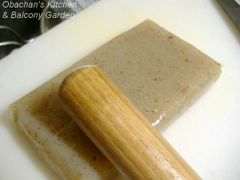 Sprinkle salt over konnyaku block and pound with a pestle or a rolling pin.* Wash and tear konnyaku into small chunks.** Put them in a saucepan, add water just to cover them, heat and bring to boil. Drain. In a pot (or a frying pan), heat vegetable oil. Add konnyaku chunks and fry for a few minutes. Add miso and heat until the miso is browned and gives out good aroma. Add sake, sugar, mirin, soy sauce and dashi stock. Simmer until the soup is thickened, stirring occasionally. Turn the heat to high and coat konnyaku with miso glaze, shaking the pot. (Add ginger juice, if desired.) Transfer to plate and sprinkle with roasted white sesame seeds. Sprinkle salt over konnyaku block and pound with a pestle or a rolling pin.* Wash and tear konnyaku into small chunks.** Put them in a saucepan, add water just to cover them, heat and bring to boil. Drain. In a pot (or a frying pan), heat vegetable oil. Add konnyaku chunks and fry for a few minutes. Add miso and heat until the miso is browned and gives out good aroma. Add sake, sugar, mirin, soy sauce and dashi stock. Simmer until the soup is thickened, stirring occasionally. Turn the heat to high and coat konnyaku with miso glaze, shaking the pot. (Add ginger juice, if desired.) Transfer to plate and sprinkle with roasted white sesame seeds. * I didn’t know this until recently, but this preparation is supposed to let excess water ooze out and make konnyaku suitable for simmering. * I didn’t know this until recently, but this preparation is supposed to let excess water ooze out and make konnyaku suitable for simmering.** Torn konnyaku chunks have ragged surface which allows better absorption of liquid seasonings. I came up with this recipe after combining a couple of recipes and adding my own twists, but still I was not totally happy with the taste. It will taste a lot differently if I use a different type of miso. -------  These are sashimi konnyaku blocks that are meant to be sliced and eaten raw like sashimi (sliced raw fish). They say this type of konnyaku contains more water and less calcium hydroxide. Sashimi konnyaku is often flavored with things like green laver or yuzu citrus. (Like so many other food products here in Kochi, deep sea water is added to these sashimi konnyaku in the photo.) These are sashimi konnyaku blocks that are meant to be sliced and eaten raw like sashimi (sliced raw fish). They say this type of konnyaku contains more water and less calcium hydroxide. Sashimi konnyaku is often flavored with things like green laver or yuzu citrus. (Like so many other food products here in Kochi, deep sea water is added to these sashimi konnyaku in the photo.)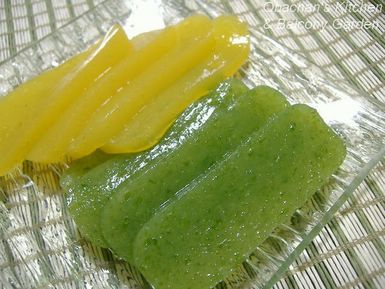 Sashimi Konnyaku --- Green Laver(Aonori) and Yuzu flavor Some people eat sashimi konnyaku with wasabi and soy sauce just like they eat sashimi, but for me sumiso (miso-vinegar dressing) is “the must.”  The way sumiso brings out the flavor of green laver or yuzu is so delightful and refreshing, and it is something particularly enjoyable on a hot summer day. I guess you could make the same kind of food out of gelatin, but I would definitely prefer the firmer and somewhat chewy texture of sashimi konnyaku in order to fully appreciate this very wafoo (Japanese-style) combination of flavors. The way sumiso brings out the flavor of green laver or yuzu is so delightful and refreshing, and it is something particularly enjoyable on a hot summer day. I guess you could make the same kind of food out of gelatin, but I would definitely prefer the firmer and somewhat chewy texture of sashimi konnyaku in order to fully appreciate this very wafoo (Japanese-style) combination of flavors.Categories: Japanese, WaFooD |
Posted by
obachan
at
5/29/2006 05:59:00 PM
7
comments
![]()
Labels: Simmered dish
Friday, May 26, 2006
I Will Be Gone for the Weekend...
I'm visiting my parents' house this weekend. Tomorrow my mom and I are going to pick sea shells (abalone -- hopefully). Hope it won't rain tomorrow, but even if it would, it won't stop us anyway ;) |
Posted by
obachan
at
5/26/2006 11:57:00 PM
3
comments
![]()
Wednesday, May 24, 2006
Because I Couldn't Find a Ripe Avocado...
 Soybean Tomato Cucumber and Shiso Salad To be perfectly honest, what I really wanted tonight was avocado and shrimp salad. But I couldn't find a ripe avocado, so I changed my mind and made this salad for my late night supper. After supper, I found a recipe for honey ginger dressing on the net. Now I'm curious -- really curious. Maybe tomorrow... ;) Categories: Western-inspired |
Posted by
obachan
at
5/24/2006 10:20:00 PM
5
comments
![]()
Labels: Salad/Dressing
Tuesday, May 23, 2006
LOOK!!
 Dog Rose ... Blooming!! Looks like I'm going to be able to pick (a few) rose hips this year!! :D So happy... because I was really disappointed last year.  And... wow!! :D (May 25, 2006) Categories: Garden |
Posted by
obachan
at
5/23/2006 02:17:00 PM
2
comments
![]()
Saturday, May 20, 2006
Super-Runny Marmalade!
 Konatsu Marmalade on a Breakfast Biscuit Yep, I did it again, and this time I almost blew it. What did I do? I made konatsu marmalade with my dad’s konatsu oranges again. Last year I had a great success, so this year I wanted to make more and give some to my mom as a belated mother’s day gift.  IIRC, last year I used about 200 g of konatsu orange peels, which was apx. 1/5 of the amount mentioned in the original recipe, and I reduced the amount of other ingredients accordingly. This time I used a little more than 500 g! Imagine how long I had to keep slicing the peels… It was almost a nightmare, even with my favorite background music on all the way through. IIRC, last year I used about 200 g of konatsu orange peels, which was apx. 1/5 of the amount mentioned in the original recipe, and I reduced the amount of other ingredients accordingly. This time I used a little more than 500 g! Imagine how long I had to keep slicing the peels… It was almost a nightmare, even with my favorite background music on all the way through.Now I remembered that last year, I kept adding konatsu juice and lemon juice at the end, which probably changed the proportion in the original recipe quite a bit. So this time I decided to follow the proportion more precisely. I put the shredded peels, sugar, konatsu juice and water in a big pot and brought them to a boil, then simmered for about an hour. At that point, the shredded peels didn’t look as soft as I remembered from last year, and the mixture seemed very runny, but I didn’t care, thinking that adding pectin at the end would make everything perfectly fine. Everything seemed fine until I added some pectin…. Still the marmalade was not thickening. I simmered it for another 15 to 20 minutes, and added a little more pectin…. Still no good… I simmered it for another 30 minutes, but still, in the pot, rather stiff peels were simmering in runny orange soup. It did not look set at all! So I added a little more pectin… and tasted the marmalade. OMG!!! IT WAS AWFULLY TERRIBLY EXTREMELY KILLINGLY SWEET!!  The tricky part, which I completely forgot this time, was that this pectin I used was pre-mixed with sugar -- yes, the kind you can directly add to the simmering fruit & juice mixture. The pectin mentioned in the original recipe was obviously not the pre-mixed type. So if I was going to use the same amount of pectin mentioned in the recipe or more, I should have reduced the amount of sugar that I added to the mixture beforehand. The tricky part, which I completely forgot this time, was that this pectin I used was pre-mixed with sugar -- yes, the kind you can directly add to the simmering fruit & juice mixture. The pectin mentioned in the original recipe was obviously not the pre-mixed type. So if I was going to use the same amount of pectin mentioned in the recipe or more, I should have reduced the amount of sugar that I added to the mixture beforehand.There I had to choose from 2 alternatives: a) runny marmalade with tolerable sweetness and some flavor of this charming citrus fruit or b) properly set marmalade with intolerable sweetness with no trace of refreshing konatsu flavor. I chose a), thinking that refrigerating would help making it thicker. To me, keeping the refreshing taste of konatsu was more important, after all. So I added more konatsu juice, lemon juice and water until I thought it was finally OK, then canned the super-runny marmalade the same way I did last year. While cooling the hot jars on the kitchen table, I went through the original recipe one more time, and found out what I forgot to do… I forgot to squeeze the water out from the shredded konatsu peels after they were soaked in water for three hours!!! :O 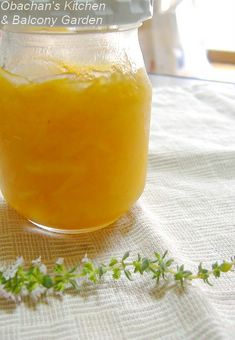 Luckily, as I had expected, refrigerating did make the marmalade a bit less runny, and taste-wise it is OK, as far as you don’t mind a little too fibery texture for marmalade. 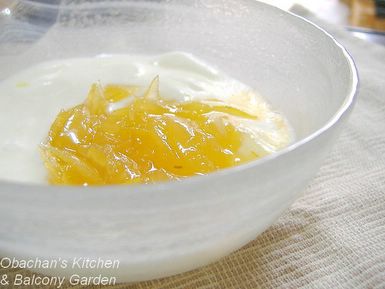 Konatsu Marmalade on Yogurt This is the best way to consume this runny marmalade, I guess. Honestly, this combination is not bad at all. I gave mom 2 small jars of this marmalade when I had lunch with her the day before yesterday, and she hasn’t called me yet to tell me whether she liked it or not. Maybe she is still looking for a politically correct way to express her impression of the marmalade. ;) Categories: Sweets,Bloopers |
Posted by
obachan
at
5/20/2006 01:00:00 PM
2
comments
![]()
Labels: Jam/Marmalade


















